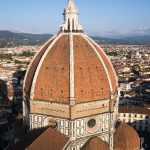
The rooftops of Florence, Italy, offer a captivating panorama that reflects the city’s rich history, architectural splendor, and cultural heritage. As one gazes upon the sea of terracotta tiles and the architectural treasures that dot the skyline, a story unfolds, weaving together the past and present of this enchanting Tuscan city.
The distinctive feature of Florence’s rooftops lies in the iconic terracotta tiles that blanket the buildings. These tiles, with their warm earthy tones, have become synonymous with the city’s architectural identity. The use of terracotta in roofing dates back to the Renaissance, and Florence, as the birthplace of this transformative era, proudly showcases this timeless tradition.
Il Duomo’s Influence
One cannot explore Florence’s rooftops without acknowledging the city’s crowning jewel—the Florence Cathedral, or Il Duomo. Dominating the skyline with its colossal dome designed by Filippo Brunelleschi, the Duomo stands as a testament to Renaissance innovation. The red-tiled dome, which took over a century to complete, crowns the Cathedral like a majestic jewel, offering a striking contrast to the sea of terracotta below.
As sunlight bathes the rooftops in a golden glow, Florence’s historic center comes to life. The tightly packed buildings, adorned with wrought-iron balconies and shuttered windows, create a mosaic of colors and textures. Each rooftop tells a story of centuries past, whispering tales of the Medici family, Renaissance artists, and the pulsating heart of Florentine life.
The Palazzo Vecchio, Florence’s town hall, is another prominent feature in the rooftop panorama. With its sturdy medieval architecture and the imposing Arnolfo Tower, the Palazzo Vecchio punctuates the skyline, serving as a visual anchor that connects the city to its medieval roots. The juxtaposition of the Palazzo Vecchio against the red-tiled rooftops encapsulates the city’s ability to seamlessly blend the old with the new.
Discovering Artisan Workshops
Wandering through the labyrinthine streets of Florence, one encounters hidden gems nestled among the rooftops—the charming, centuries-old artisan workshops. These workshops, often tucked away on the upper floors of buildings, have been the cradle of Florentine craftsmanship for generations. From traditional leatherworking to intricate goldsmithing, these rooftops harbor the essence of Florence’s artisanal soul.
The Arno River, gracefully winding its way through the city, introduces yet another layer to the rooftop tapestry. The Ponte Vecchio, adorned with its vibrant array of shops, stretches across the river, providing a unique vantage point to admire the rooftops. From this iconic bridge, the eye can trace the undulating rooflines that define Florence’s skyline, each peak telling a story of a bygone era.
As evening descends upon Florence, the rooftops undergo a transformation. Warm tones give way to the soft glow of streetlights, and the distant hills beyond the city become silhouettes against the twilight sky. The Duomo, now illuminated, stands as a beacon, casting its glow over the rooftops and inviting contemplation of the city’s artistic and cultural legacy.
Function & Beauty
In addition to their aesthetic allure, Florence’s rooftops serve a practical purpose in the city’s architectural design. The angled pitches of the roofs, characteristic of Tuscan architecture, are not merely decorative but are rooted in functionality. The incline allows rainwater to flow away efficiently, a design feature born out of centuries of practical wisdom.
Florence’s rooftops also bear witness to the city’s resilience in the face of historical challenges. The red tiles, weathered by time, echo the endurance of a city that has weathered wars, political upheavals, and cultural shifts. Each tile, each rooftop, contributes to the narrative of Florence’s endurance and its ability to preserve its identity through the ages.
In conclusion, the rooftops of Florence, with their terracotta hues, architectural landmarks, and artisanal workshops, encapsulate the essence of this timeless city. From the monumental dome of the Florence Cathedral to the hidden ateliers preserving age-old craftsmanship, the rooftops narrate the story of a city that has been a cradle of art, culture, and innovation for centuries. As one looks out over the rooftops, the spirit of Florence unfolds—a city that, like its red-tiled crowns, stands resilient and proud, inviting all who gaze upon it to become part of its enduring tale.




